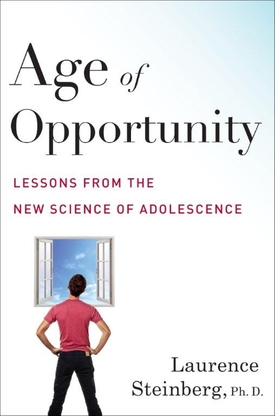I’ve just finished reading the book Age of Opportunity – Lessons from the New Science of Adolescence by Laurence Steinberg, Ph.D. At 217 pages, it’s not an overly long book but it is absolutely packed with information. I did spend a lot of time reading it (normally I’m a pretty fast reader) because I was learning so much.
Dr. Steinberg begins the book by emphasizing that adolescence is a critical time when parents, teachers, and adults in general can do much to help young people develop. He explains that just as young children’s brains are very malleable and open to learning in the first few years (a state referred to as “plastic”) so too are adolescents. Interestingly, the more that adolescent brains are stimulated with learning challenges, the longer the span of plasticity will last. This can result in adults who are more competent and successful in their lives.
Dr. Steinberg explains also that there is a difference between puberty (the hormonal changes that transform us into adults) and adolescence (the stage between childhood and adulthood). You may have noticed that adolescence has lengthened over the past few decades. Because we often define the end of the stage with behaviors like employment and marriage, it’s easy to see that it’s lasting longer. Young people are taking longer to finish school, get employed in career tracks, and move out on their own.
I will admit to being a person who saw this trend as negative, but after reading this book I’m convinced differently. Because the adolescent brain is more plastic and malleable, individuals can learn more become better (happier, skilled, and more stable) adults. That sounds good to me.
With anecdotal evidence and 40 years of studies, Steinberg lays out the case that young people between the age of 10 and 25 need our help. There are things we as parents can do to help establish the best conditions for growth and development. Dr. Steinberg advocates for straightforward things like nutrition, avoidance of endocrine-interrupting chemicals (think organic), adequate sleep, and avoidance of screens. He also says parents need to be authoritative: structured but warm and flexible. This is a bigger challenge but one I think people can learn to meet. Parents also need to supervise adolescents carefully, help them avoid overly stressful situations, and keep them out of situations where they are prone to bad choices.
The good doctor has a lot to say about self-regulation. Another description for that might be self-control. Either way, individuals who can self regulate are more likely to manage well in life. I was also pleased to read his analysis of success and how people achieve it. A big point (that I made sure to read to one of the older boys) is that the biggest factor in success isn’t intellect. It’s the willingness to work hard; hence the importance of self-regulation.
There’s far more content in this book than I can lay out here in this review, so I do encourage you to read it yourself. Parents, educators, and employers need to consider this information and then look at how they can help young people through adolescence. Dr. Steinberg does say that there are groups who disagree with adolescent research. As an individual not trained and experienced in this field, I cannot speak with authority to the validity and reliability of this book. However, the arguments and conclusions sounded reasonable to me. I do recommend people read and consider this book.
In terms of my own experience with this book, I do have one strong objection. Steinberg describes a time when he was called to be an expert witness in defense of a young man being sued for defamation. The young man had indeed done something foolish, to be sure. The case came to trial in the year 2000. Dr. Steinberg describes his drive to the courthouse thinking that there was no way the boy would lose since there is such a clear difference between youthful foolishness and criminal behavior. On his way he noticed that there were fewer and fewer campaign signs for Al Gore and began to feel a sense of dread. Sure enough, the jury found against the young man and penalized him with a hefty fine.
Of all people, a person as experienced as Dr. Steinberg (40 years as a developmental psychologist) would know that human behavior is never simple. I find the insinuation offensive that not having a particular political leaning would therefore result in a harsh decision. And really, fewer campaign signs in a neighborhood could be the result of multiple factors. There’s just no reason to characterize nearly 40% of the population as harsh and unfeeling just because of their political leanings. With the rest of the book written with such and even hand, this inclusion of bias was quite disappointing.
That objection aside, I do still think this book is a valuable contribution to parenting and education in the US. Dr. Steinberg makes the point that after decades of trying to improve the education outcomes for our young people we’ve had no results. I see plenty of hope in implementing his recommendations as they make a lot of sense to me and could indeed yield a great harvest of competent, stable, and happy adults.



It sounds like this book has a wealth of information to offer parents and educators! I’m glad to see that you can recommend it so highly. Thanks for being a part of the tour!